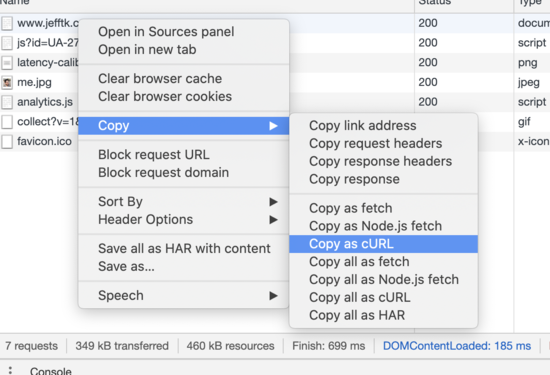HTTP offers a convenient way to download only the headers: send a HEAD request:
$ telnet www.example.com 80 Trying 93.184.216.34... Connected to www.example.com. Escape character is '^]'. HEAD / HTTP/1.1 Host: www.example.com HTTP/1.1 200 OK Content-Encoding: gzip Accept-Ranges: bytes Age: 325063 Cache-Control: max-age=604800 Content-Type: text/html; charset=UTF-8 Date: Tue, 17 Nov 2020 02:29:50 GMT Etag: "3147526947" Expires: Tue, 24 Nov 2020 02:29:50 GMT Last-Modified: Thu, 17 Oct 2019 07:18:26 GMT Server: ECS (dcb/7F82) X-Cache: HIT Content-Length: 648Of course you wouldn't usually manually type into
telnet,
you'd use something like
curl:
$ curl -I http://www.example.com HTTP/1.1 200 OK Accept-Ranges: bytes Age: 326121 Cache-Control: max-age=604800 Content-Type: text/html; charset=UTF-8 Date: Tue, 17 Nov 2020 02:47:38 GMT Etag: "3147526947" Expires: Tue, 24 Nov 2020 02:47:38 GMT Last-Modified: Thu, 17 Oct 2019 07:18:26 GMT Server: ECS (dcb/7EC9) X-Cache: HIT Content-Length: 1256It's defined in RFC 7231:
The HEAD method is identical to GET except that the server MUST NOT send a message body in the response (i.e., the response terminates at the end of the header section). The server SHOULD send the same header fields in response to a HEAD request as it would have sent if the request had been a GET, except that the payload header fields MAY be omitted.
Unfortunately, HEAD is a trap. When you are trying to debug strange server behavior, it is much safer to send GET requests and throw away the body (ex, ex). Not only is "SHOULD" just a recommendation, but even if this were a "MUST" you could bet some servers would mishandle it. Counterfactuals are hard!
While differences are rare, always debugging by requesting the body like a normal client would, and then discarding it, means one fewer way that your debug request differs from a real one:
$ curl -sS -D- -o/dev/null http://www.example.com HTTP/1.1 200 OK Accept-Ranges: bytes Age: 326124 Cache-Control: max-age=604800 Content-Type: text/html; charset=UTF-8 Date: Tue, 17 Nov 2020 02:47:41 GMT Etag: "3147526947" Expires: Tue, 24 Nov 2020 02:47:41 GMT Last-Modified: Thu, 17 Oct 2019 07:18:26 GMT Server: ECS (dcb/7EC9) Vary: Accept-Encoding X-Cache: HIT Content-Length: 1256
Going farther in the same direction, it's even better to start with "Copy as cURL":
And then add the -sS -D- -o/dev/null to get the headers if
that's all you want.
Comment via: facebook
